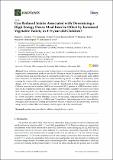Can reduced intake associated with downsizing of a high energy dense meal item be offset by increased vegetable variety in 3-5-year-old children?
Abstract
Large portions of energy dense foods promote overconsumption but offering small portions might lead to compensatory intake of other foods. Offering a variety of vegetables could help promote vegetable intake and offset the effect of reducing the portion size (PS) of a high energy dense (HED) food. Therefore, we tested the effect on intake of reducing the PS of a HED unit lunch item while varying the variety of the accompanying low energy dense (LED) vegetables. In a within-subjects design, 43 3–5-year-old pre-schoolers were served a lunch meal in their nursery on 8 occasions. Children were served a standard (100%) or downsized (60%) portion of a HED sandwich with a side of LED vegetables offered as a single (carrot, cherry tomato, cucumber) or variety (all 3 types) item. Reducing the PS of a HED sandwich reduced sandwich (g) (p < 0.001) and total meal intake (kcal) consumption (p = 0.001) without an increased intake of other foods in the meal (LED vegetables (p = 0.169); dessert (p = 0.835)). Offering a variety of vegetables, compared with a single vegetable, increased vegetable intake (g) (p = 0.003) across PS conditions. Downsizing and variety were effective strategies individually for altering pre-schoolers’ intakes of HED and LED meal items, however, using variety to offset HED downsizing was not supported in the present study.
Citation
Carstairs , S A , Caton , S J , Blundell-Birtill , P , Rolls , B J , Hetherington , M M & Cecil , J E 2018 , ' Can reduced intake associated with downsizing of a high energy dense meal item be offset by increased vegetable variety in 3-5-year-old children? ' , Nutrients , vol. 10 , no. 12 , 1879 . https://doi.org/10.3390/nu10121879
Publication
Nutrients
Status
Peer reviewed
ISSN
2072-6643Type
Journal article
Description
This work was supported by the BBSRC, Diet and Nutrition Research Industry Club [grant numbers BB/M027384/1].Collections
Items in the St Andrews Research Repository are protected by copyright, with all rights reserved, unless otherwise indicated.

